Dell XPS 15 L521X: A Detailed First Look
by Jarred Walton on July 25, 2012 1:10 AM ESTDell XPS 15 LCD: Decent Contrast and Brightness, Mediocre Colors
Dell’s XPS line has had a bit of an on-again, off-again relationship with good LCDs. The M1710 and M1730 way back in the day had good WUXGA panels for the time, and the Studio XPS 16 was the first laptop to offer an RGB LED backlit panel (at least to my knowledge). More recently, the XPS 15 and 15z 1080p panels have been good, but the 768p displays in the XPS 13, 14, 14z, 15, and 15z have all been run of the mill offerings. Thankfully, the new XPS 15 sticks with the pattern of offering a decent 1080p display. It’s not great and has a definite bluish tint, but contrast is pretty good. If you don’t demand accurate colors (which is easily answered by answering this question: do you own a hardware colorimeter?), then the XPS 15 should be good enough to keep you happy. Even with a colorimeter, however, color accuracy remains relatively poor compared to other panels.
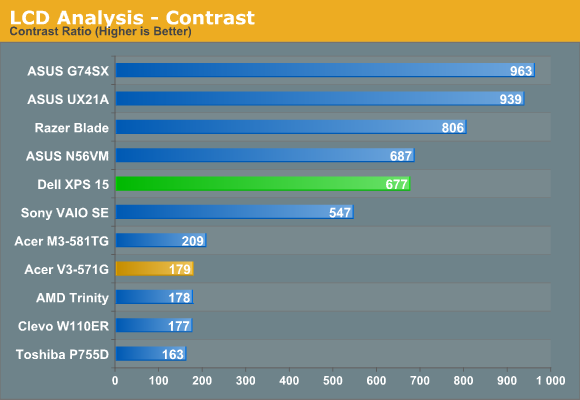
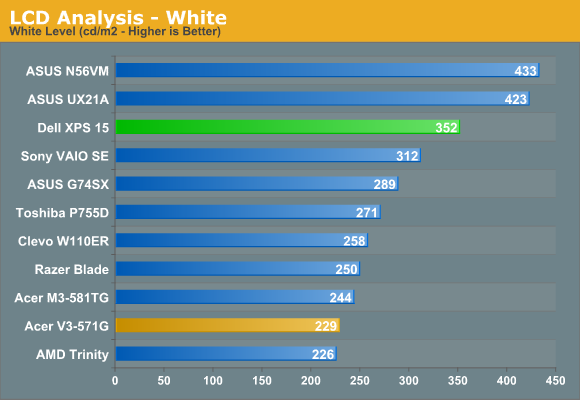
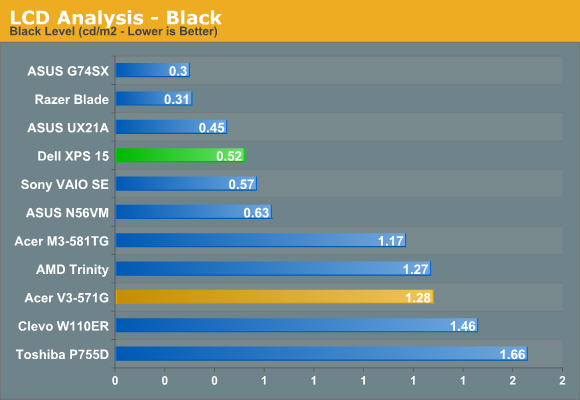
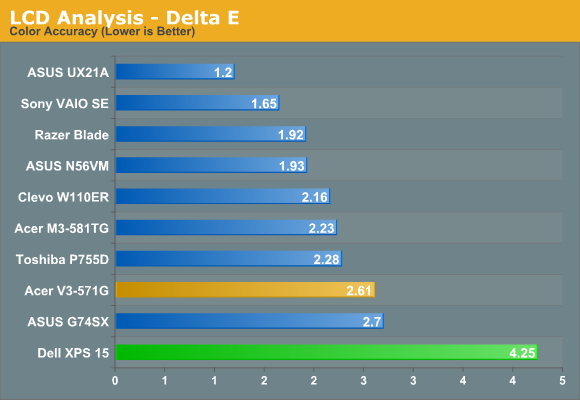
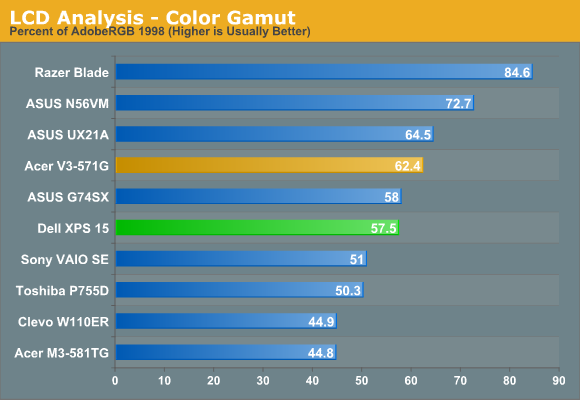
Contrast checks in at 677:1, which is better than average but not exceptional. The maximum white level is 350 nits, but that’s with a very strong blue component. Once you calibrate to remove that, the maximum white level drops substantially down to just 250 nits. If you prefer “cool” colors, the LCD will probably make you happy, but those who prefer natural or warmer colors will immediately notice something is off. As noted above, delta E even after calibration is quite poor—just like the XPS 15z. That would make sense, as the two models appear to use the same AU Optronics B156HW03 panel. Color gamut is likewise middling, at 57% of Adobe RGB.
The minor complaints with the panel continue when we look at viewing angles. I’ve seen some TN panels that do a lot better in terms of vertical viewing angles; this LCD isn’t one of those. Viewed from above or below, you get severe color shifting and loss of contrast. There’s still a decent viewing arc where the LCD looks good, but this is on the lower end of the 1080p LCDs that we’ve tested. I also noticed a fair amount of “shimmer” on the edges of windows when moving them around, which appears to come from the 6-bit to 8-bit color interpolation. That’s almost always present to varying degrees, but here it’s as noticeable as on lesser LCDs like that in the Acer V3-571G.
While the IPS panels in laptops like the UX21A, Sony VAIO SE, HP Envy 15, and Lenovo X220 aren’t perfect by any means, they’re still a substantial upgrade from panels like this—and this panel in turn is a substantial upgrade from the poor quality 1366x768 panes. We’d love to see more vendors push for IPS panels, and that goes double (triple even!) for high-end laptops like this XPS 15. If you’re paying under $1000 for a laptop, we understand the need to make some compromises, but ASUS has managed to get 1080p IPS displays into their new 11.6” and 13.3” Ultrabooks so there’s really no excuse for using a lower quality TN panel in a $1300+ laptop. And it almost goes without saying that Apple’s new 2880x1800 Retina MacBook Pro is in a league of its own.
















109 Comments
View All Comments
xype - Wednesday, July 25, 2012 - link
Never said it was the pinnacle. But feel free to educate me how above industry average growth is "struggling" or, alternatively, show me some data for the past 5 years that shows Apple’s sales dipping lower than those of their competitors.Unless, for some reason, Apple gets paid with magic dollars that increase their value after Apple receives them, their PC profits do not come about from "struggling".
But hey, since you told me, I’m gonna get a real hard grip on my desk now while you look for data to support your claims. Wheee!
ananduser - Wednesday, July 25, 2012 - link
Above average industry growth ? You should check Lenovo and Asus' numbers for above average growth, double digits. For the most recent quarter Apple stagnated.xype - Thursday, July 26, 2012 - link
Ugh. Yeah, most recent quarter. That totally negates the past, what, 5 years? Apple is doomed! o_Oananduser - Thursday, July 26, 2012 - link
I didn't say that. You seem to extract Apple out of the PC landscape like they were pushing PowerPC hardware. Not anymore. Ever since they switched to Intel their growth was steady but small. So no Apple does not have above average industry growth. Other PC OEMs do.CeriseCogburn - Sunday, July 29, 2012 - link
Hey you got overconfident and he upped the ante and provided the heat that destroyed your smug appletude.The least you should have done is take it like an appleseed, but instead you smarted off and made up a sucky strawman.
tsk tsk, Steve is disappointed. You're fired.
yyrkoon - Wednesday, July 25, 2012 - link
Except, those "PC makers" who are "retards" actually contribute to the technology specifications. For hardware used in your precious Apple systems.x86-64 CPU's /chipsets, nVidia graphics cards, SATA, PCIe, Thunderbolt, , etc, etc.
Matter of a fact. Apple did not even make the first laptop. Epson 1981, Microsoft 1982, Compaq 1988, IBM 1984, Radio Shack 1983 ( In collaboration with Microsoft ), and possibly NEC 1989 all had designs before Apple in 1989. Not to mention others dating back to 1979.
So who is thinking "differently" again ? Do not even get me started on OSX.
So, if not for the technology giants of the world. Apple would not even have existed. Like many others in the industry, they take the ideas from others, and improve on them. Improvement is also a subjective term in this situation.
xype - Thursday, July 26, 2012 - link
Who contributes to technology specifications? Dell? Asus? Acer? HP?Did Intel start targeting the ultra-low-power CPU specs because of all of these guys, who made the first "Ultrabook"?
And how "special" do you have to be to think I was claiming Apple made the first laptop? Duh?
Unibody aluminium enclosures, retina display, the ultrabook form factor, thunderbolt, etc are not popping up in Acers and Asuses and Dells first. I’m NOT claiming Apple is the end all be all (as some specialitos here seem to think), but they DO contribute their share to the ecosystem and claiming they don’t and that they are just "assembling" PC parts is reeking of butthurt, especially seeing how HP and now Dell seem completely unable to make "premium" laptops that don’t looks like MacBook knock-offs.
Which is my original point: it’s annoying that they don’t, because people are not buying only Macs and it would be really nice to have some hardware that actually looked different. They just don’t give enough of a shit.
yyrkoon - Friday, July 27, 2012 - link
The point was. Apple does currently makes a system that is based on PC ( x86 compatible ) parts. They do not come up with technology ideas. They buy decent / good parts and assemble them. Then they write a limited driver base into their operating system to support such hardware.Which in fact is a good idea, but very limited. General purpose computing, that is limited by software support. For software titles, and additional hardware. Then, it is also very proprietary in comparison to other alternatives. You're locked into their hardware, and software.
The reason why OEM PC vendors "dont give a shit" is that such systems cost a lot, and PC system purchasers are cheap. If you were to compare lets say Dell to Apple. I think you would find that Dell probably sells many more systems *This* is an "Apple" to Apples comparison. Now, as for who actually makes more money . . . I have no idea. Nor do I care.
As far as who actually contributes to PC technology. Try using google. I think you would very likely find Intel, AMD, IBM, supermicro, and Epson among them. Then, many others in the PC industry like Asus.
CeriseCogburn - Sunday, July 29, 2012 - link
A black keyboard area is a scourge on us all.Used to be you could see all laptop keyboards in the dark without back lighting, until the pliable masses were all doggy trained into loving black on everything - now they're just invisible past dusk. Pavlov man - the training is actually amazing.
Yeah, so strike one for the crap black keyboard and area, and I include the mindless drooling dogams in that strike as well.
That's also why they all make maccy looking clones- because the idiot masses respond like clockwork.
yyrkoon - Wednesday, July 25, 2012 - link
Jarred, how about setting processor affinity to 2 cores only ? Then retesting a game or two ? The results should be interesting.I'm thinking that game performance should get a boost, and CPU temps should drop some.